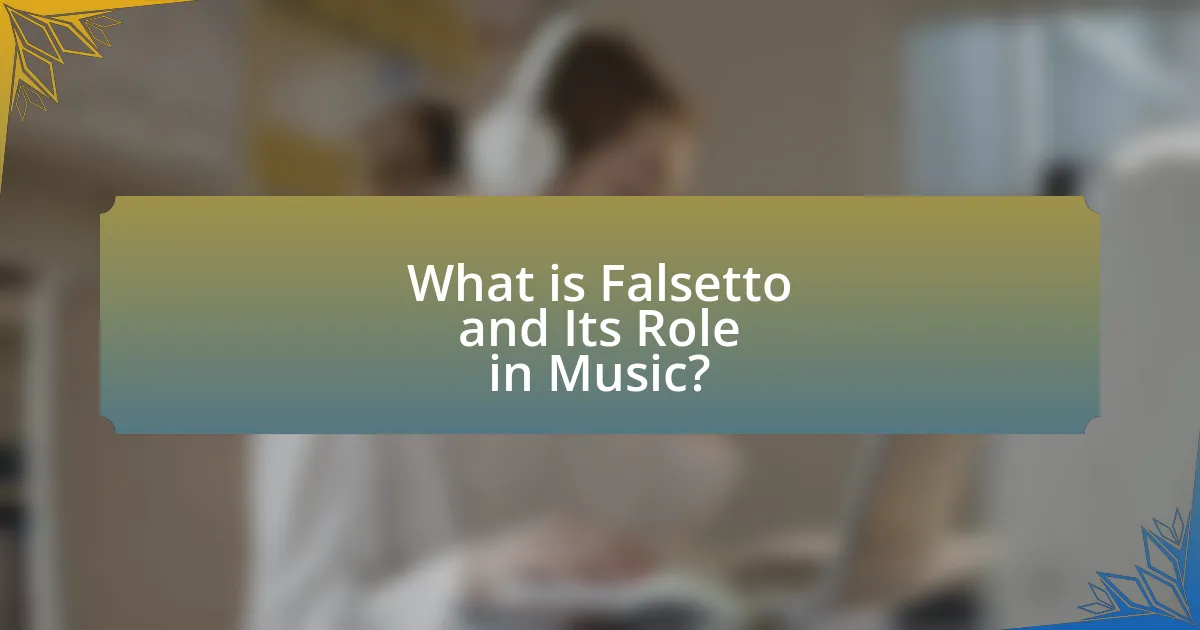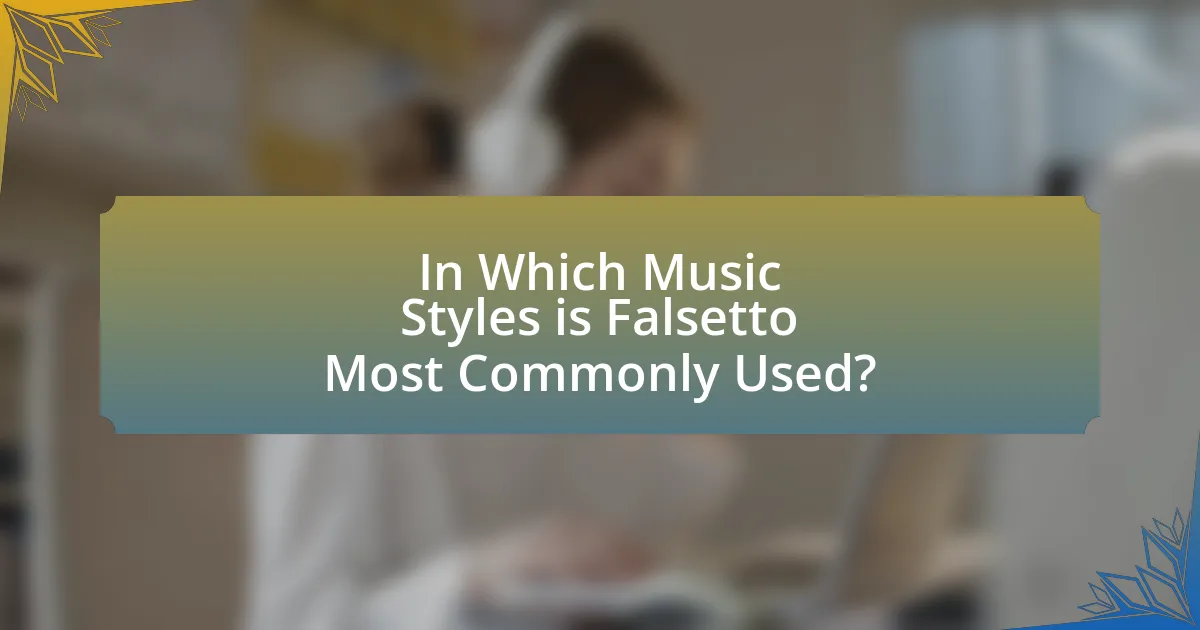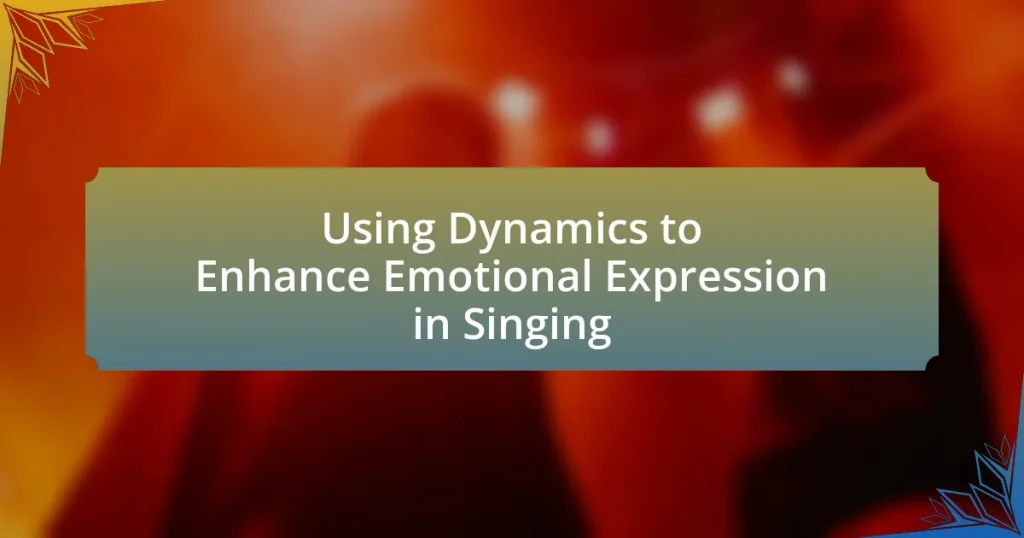Falsetto is a vocal technique that enables singers to produce higher pitches beyond their normal range, playing a crucial role in various music styles such as pop, R&B, and classical. This article explores the definition of falsetto, its distinction from other vocal registers, and its impact on vocal range and quality. It highlights the emotional effects falsetto conveys in music, its significance across different genres, and the techniques singers can use to develop and maintain their falsetto voice. Additionally, the article discusses the challenges associated with falsetto singing and offers strategies for effective use in performances and songwriting.

What is Falsetto and Its Role in Music?
Falsetto is a vocal technique that allows singers to produce notes higher than their normal range by using the vocal cords in a specific way. This technique plays a significant role in various music styles, particularly in genres like pop, R&B, and classical, where it adds emotional depth and a unique tonal quality to performances. For example, artists such as Prince and Justin Timberlake have effectively utilized falsetto to enhance their vocal expression and create memorable melodies. The use of falsetto can also be traced back to historical figures like the castrati in Baroque opera, who relied on this technique to achieve their distinctive sound.
How is falsetto defined in vocal techniques?
Falsetto is defined in vocal techniques as a method of voice production that enables singers to reach pitches higher than their normal range by using the vocal cords in a specific way. This technique involves the use of the ligamentous edges of the vocal folds, allowing for a lighter, airier sound compared to full chest voice. Falsetto is commonly utilized in various music styles, including pop, classical, and R&B, to create distinct vocal effects and emotional expression.
What distinguishes falsetto from other vocal registers?
Falsetto is distinguished from other vocal registers by its production of higher pitches through the use of the vocal cords in a relaxed state, allowing for a lighter, airier sound. Unlike modal voice, which utilizes the full vocal fold length and mass, falsetto engages only the edges of the vocal folds, resulting in a thinner tone. This technique is often characterized by a lack of vocal cord closure, leading to a breathy quality. Research indicates that falsetto can extend a singer’s range significantly, enabling access to notes that are typically beyond the modal voice range, thus making it a unique and valuable tool in various music styles.
How does falsetto affect vocal range and quality?
Falsetto expands vocal range by allowing singers to reach higher pitches that are typically beyond their modal voice capabilities. This technique engages the vocal cords differently, resulting in a lighter, airier sound quality compared to full chest voice. Research indicates that singers using falsetto can access notes up to an octave higher than their normal range, enhancing their overall vocal versatility. Additionally, the quality of sound produced in falsetto often lacks the richness and resonance found in modal voice, which can affect the emotional impact of a performance.
Why is falsetto significant in various music styles?
Falsetto is significant in various music styles because it allows singers to access higher vocal registers, enhancing emotional expression and stylistic versatility. In genres like pop, R&B, and opera, falsetto creates a distinct sound that can convey vulnerability or power, making it a valuable tool for artists. For instance, artists such as Prince and Justin Timberlake have effectively used falsetto to add depth to their performances, demonstrating its impact on listener engagement and musical dynamics. Additionally, historical contexts show that falsetto has been utilized in classical music for centuries, highlighting its longstanding importance across diverse musical traditions.
What emotional effects does falsetto convey in music?
Falsetto conveys a range of emotional effects in music, primarily evoking feelings of vulnerability, intimacy, and expressiveness. This vocal technique often elicits a sense of longing or nostalgia, as it can create a delicate and airy sound that contrasts with the more powerful chest voice. Research indicates that falsetto can enhance emotional expression by allowing singers to convey nuanced feelings, as demonstrated in genres like pop and R&B, where artists frequently use falsetto to evoke deeper emotional connections with listeners. For instance, artists such as Prince and Jeff Buckley have effectively utilized falsetto to amplify the emotional impact of their performances, showcasing its ability to resonate with audiences on a profound level.
How does falsetto contribute to the identity of different genres?
Falsetto significantly contributes to the identity of different music genres by adding emotional depth and stylistic distinction. In genres like pop and R&B, artists such as Prince and Justin Timberlake utilize falsetto to convey vulnerability and expressiveness, which enhances the emotional connection with listeners. In contrast, in rock music, bands like Queen and The Beach Boys employ falsetto to create a unique sound texture, setting them apart from their contemporaries. The use of falsetto in these contexts not only defines the vocal style but also influences the overall genre identity, as it becomes a recognizable characteristic that fans associate with specific artists and their music.

In Which Music Styles is Falsetto Most Commonly Used?
Falsetto is most commonly used in pop, R&B, and classical music styles. In pop music, artists like Justin Timberlake and Prince frequently employ falsetto to achieve emotional expression and vocal range. In R&B, singers such as Usher and Mariah Carey utilize falsetto to convey intimacy and passion. Classical music, particularly in operatic performances, showcases falsetto in male countertenors, allowing them to reach higher pitches that are essential for certain roles. These examples illustrate the versatility and significance of falsetto across these genres.
What are the primary genres that utilize falsetto?
The primary genres that utilize falsetto include pop, R&B, rock, and classical music. In pop music, artists like Justin Timberlake and Prince frequently employ falsetto to create emotional depth and highlight vocal range. R&B singers such as Usher and Mariah Carey use falsetto to convey intimacy and expressiveness. In rock, bands like Queen and The Beach Boys have famously incorporated falsetto to enhance their vocal harmonies and create distinctive sounds. Classical music also features falsetto, particularly in operatic performances, where it is used to achieve a higher vocal register and add dramatic effect.
How is falsetto employed in pop music?
Falsetto is employed in pop music primarily to create a distinct vocal texture that enhances emotional expression and adds variety to a song. Artists like Justin Timberlake and Mariah Carey utilize falsetto to reach higher pitches that their natural voices may not achieve, allowing for a more dynamic range and captivating performances. The use of falsetto in pop often serves to convey vulnerability or intensity, as seen in tracks like “Cry Me a River” and “Vision of Love,” where the falsetto passages evoke strong emotional responses from listeners. This technique has become a hallmark of contemporary pop, demonstrating its effectiveness in engaging audiences and elevating the overall musical experience.
What role does falsetto play in R&B and soul music?
Falsetto plays a crucial role in R&B and soul music by allowing vocalists to express a wide range of emotions and create a distinctive sound. This vocal technique enables singers to reach higher pitches that are often associated with vulnerability and passion, enhancing the emotional depth of their performances. Notable artists like Marvin Gaye and Prince have effectively utilized falsetto to convey longing and intimacy in their songs, demonstrating its significance in the genre. The use of falsetto in R&B and soul is not just a stylistic choice; it has become a defining characteristic that shapes the overall aesthetic and emotional impact of the music.
How does falsetto manifest in classical and opera?
Falsetto in classical and opera manifests as a vocal technique that allows singers to reach pitches beyond their normal range, typically in the higher register. This technique is often employed by male singers to produce notes that are higher than their modal voice, creating a distinct, airy sound that is characteristic of certain roles and styles within these genres.
In classical music, falsetto is utilized to convey emotional depth and to enhance the expressiveness of the performance, particularly in arias and lieder. In opera, it is frequently used in specific character portrayals, such as in the roles of young boys or certain comedic characters, where the lightness and ethereal quality of falsetto can add to the dramatic effect.
Historical examples include the use of falsetto by countertenors, who specialize in this technique, allowing them to perform baroque music that requires higher vocal lines originally written for castrati. The effectiveness of falsetto in these contexts is supported by its ability to blend seamlessly with orchestral textures, as seen in works by composers like Handel and Vivaldi, where the unique timbre of falsetto enhances the overall musical experience.
What techniques are used by classical singers to achieve falsetto?
Classical singers achieve falsetto primarily through techniques such as breath control, vocal cord adjustment, and resonance tuning. Breath control allows singers to manage airflow, which is essential for producing a light, airy sound characteristic of falsetto. Vocal cord adjustment involves the use of the vocal folds in a way that they vibrate differently than in modal voice, creating a higher pitch. Resonance tuning is the adjustment of vocal tract shape to enhance the sound quality and projection of the falsetto voice. These techniques are supported by vocal training methods that emphasize the importance of proper technique to avoid strain and ensure vocal health.
How does falsetto enhance operatic performances?
Falsetto enhances operatic performances by allowing singers to access higher vocal registers, which can create a unique emotional resonance and expand the range of musical expression. This technique enables performers to produce notes that are often beyond their natural vocal range, thereby enriching the overall sound and adding a layer of complexity to the character they portray. Historical examples include the use of falsetto in the works of composers like Mozart and Handel, where it was employed to convey vulnerability or otherworldliness in characters, demonstrating its effectiveness in enhancing dramatic impact.

What Techniques and Practices Enhance the Use of Falsetto?
Techniques and practices that enhance the use of falsetto include breath control, vocal exercises, and proper posture. Breath control is essential as it provides the necessary support for sustained falsetto notes, allowing singers to maintain pitch and clarity. Vocal exercises, such as scales and sirens, help strengthen the vocal cords and improve flexibility, making it easier to transition between registers. Proper posture ensures that the singer’s airflow is unobstructed, facilitating better resonance and sound quality. Research indicates that consistent practice of these techniques can lead to improved vocal performance, as evidenced by studies on vocal pedagogy that highlight the importance of these foundational skills in developing a strong falsetto.
How can singers develop their falsetto voice?
Singers can develop their falsetto voice through consistent practice, vocal exercises, and proper technique. Engaging in specific exercises such as sirens, scales, and breath control techniques helps strengthen the vocal cords and improve range. Additionally, focusing on relaxation and proper posture allows for better airflow and resonance, which are crucial for producing a clear falsetto sound. Research indicates that regular vocal training can enhance vocal flexibility and control, leading to a more developed falsetto.
What exercises are effective for improving falsetto range?
Effective exercises for improving falsetto range include sirens, lip trills, and vocal slides. Sirens involve gliding through your vocal range from low to high and back, which helps in stretching and strengthening the falsetto. Lip trills, where you produce sound while blowing air through closed lips, promote relaxation and control in the upper register. Vocal slides, or glissandos, allow singers to transition smoothly between notes, enhancing flexibility and range. These exercises are supported by vocal pedagogy principles that emphasize the importance of consistent practice and proper technique for vocal development.
How does breath control impact falsetto singing?
Breath control significantly impacts falsetto singing by providing the necessary support for sustained notes and pitch accuracy. Effective breath control allows singers to manage airflow, which is crucial for maintaining vocal fold tension and resonance in the falsetto register. Studies indicate that singers with strong breath control can produce a clearer and more stable falsetto sound, as they can regulate the pressure and flow of air, preventing strain and facilitating smoother transitions between registers. This is supported by vocal pedagogy research, which emphasizes the importance of diaphragmatic breathing techniques in enhancing vocal performance, particularly in styles that utilize falsetto.
What are common challenges faced when using falsetto?
Common challenges faced when using falsetto include difficulty in maintaining vocal control, inconsistency in tone quality, and strain on the vocal cords. Vocal control can be compromised due to the lighter, breathier quality of falsetto, making it harder for singers to execute precise pitches. Inconsistency in tone quality arises because falsetto often lacks the richness and fullness of modal voice, leading to variations in sound that can affect performance. Additionally, strain on the vocal cords can occur if singers push their voices beyond comfortable limits, potentially leading to vocal fatigue or injury. These challenges are documented in vocal pedagogy literature, emphasizing the need for proper technique and practice to mitigate risks associated with falsetto singing.
How can singers overcome difficulties in transitioning to falsetto?
Singers can overcome difficulties in transitioning to falsetto by practicing specific vocal exercises that strengthen the head voice and improve breath control. These exercises, such as sirens and scales, help singers develop a smoother transition between their chest voice and falsetto. Research indicates that consistent practice of these techniques can enhance vocal flexibility and reduce strain, making the transition more seamless. Additionally, understanding the anatomy of the vocal cords and how they function during falsetto can aid singers in achieving better control and resonance.
What tips can help maintain vocal health while using falsetto?
To maintain vocal health while using falsetto, singers should prioritize proper hydration, warm-up exercises, and vocal rest. Hydration keeps the vocal cords lubricated, reducing strain during falsetto use. Warm-up exercises, such as gentle scales and lip trills, prepare the voice for higher pitches, minimizing the risk of injury. Vocal rest is essential to allow the vocal cords to recover, especially after extensive use of falsetto. Research indicates that consistent hydration and proper vocal techniques significantly reduce the likelihood of vocal strain and damage, supporting long-term vocal health.
What are the best practices for incorporating falsetto in performances?
The best practices for incorporating falsetto in performances include proper vocal warm-ups, controlled breath support, and stylistic integration. Vocal warm-ups prepare the voice for the demands of falsetto, reducing the risk of strain and enhancing vocal flexibility. Controlled breath support is essential, as it allows for sustained notes and dynamic expression, which are crucial when using falsetto. Additionally, integrating falsetto stylistically within the song enhances emotional delivery and aligns with the genre’s characteristics, as seen in pop and R&B music where falsetto is often used for expressive high notes. These practices ensure that falsetto is executed effectively and contributes positively to the overall performance.
How can falsetto be effectively used in songwriting?
Falsetto can be effectively used in songwriting to convey emotion and create dynamic contrast within a piece. By incorporating falsetto, songwriters can evoke feelings of vulnerability or intensity, enhancing the overall emotional impact of the song. For instance, artists like Prince and Jeff Buckley have utilized falsetto to express deep emotional nuances, demonstrating its effectiveness in connecting with listeners. Additionally, falsetto can serve as a stylistic choice that distinguishes a song, allowing for unique vocal textures that can captivate an audience. This technique has been widely adopted across various genres, including pop, rock, and R&B, showcasing its versatility and significance in modern songwriting.
What strategies can enhance audience engagement through falsetto?
Utilizing falsetto effectively can significantly enhance audience engagement by creating emotional resonance and dynamic contrast in performances. Strategies to achieve this include varying vocal intensity and pitch to evoke different emotions, which can captivate listeners. For instance, artists like Prince and Jeff Buckley have employed falsetto to convey vulnerability and passion, drawing audiences into their emotional narratives. Additionally, incorporating falsetto during climactic moments in a song can create a powerful contrast with the rest of the performance, heightening the overall impact and keeping the audience engaged. Research indicates that vocal techniques, including falsetto, can influence listener perception and emotional response, reinforcing the effectiveness of these strategies in live performances.















